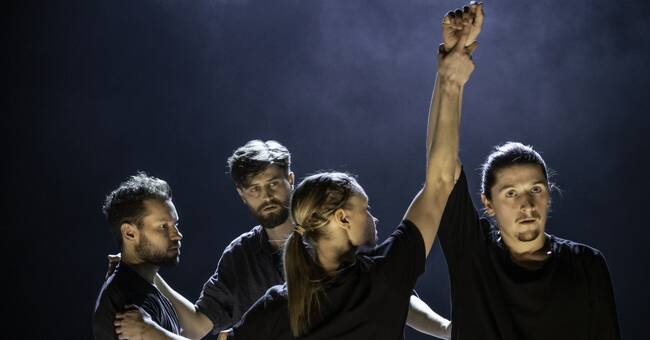Let's start with the music.
Berlin-based Nils Frahm is known for his unconventional way of using the piano.
His music is exalted piano clink, with the peculiarity that it breathes.
In addition to the notes, you hear the piano's mechanics, a pedal pumping, the pianist's oxygen collection.
Kenneth Kvarnström has limited himself to an album, Solo remains, and thus challenged himself.
Scenen är stilren och skarpt skuren, som så ofta när arkitekturintresserade Kvarnström är i farten. Och det börjar så mjukt så mjukt. De fyra dansarna i rena strumpor på ljus heltäckningsmatta. Svartklädda kroppar som böljar, flyter. Ett virrvarr av kroppar, rörelsens poesi som Kvarnström själv uttrycker det. Dansarna iklädda klockformade tunikor gungar likt smågranar i stormbyar. En lek måhända men också ett uttryck för människans obetvingliga lust att röra sig.
Då börjar sönderfallet. Dansarna Ida Holmlund och Anton Borgström med bakgrund i street-dance använder sig av popping-genrens spasmiska rörelsemönster för att gestalta kroppens dekonstruktion. Men det är ett nedskruvat mönster, som om kraften sipprar ur. De andra dansarna kommer till undsättning, stöttar upp, bär, men förfallet fortgår.
It is not a party of laughter
and nothing for those who shun the dark sides of life.
But Kvarnström fills the room with play.
He himself stands in the background and paints for a happy life.
Reshuffles the scenography, highlights props.
A craft corner takes over where the dancers are equipped with glue sticks and a cut-up portrait that will soon cover Kvarnström's panel.
The playfulness, however, balances on a knife edge.
There is a risk that it will fall into a handicraft workshop.
A scene where the dancers seem to get stuck in a bundle of iron rings lacks pregnancy and energy.
Still, Piano Topographies become a congenial encounter.
Nils Frahm's music oscillates between tones and silence, movement and rest.
This is where the performance strives, to the starting point of the dance, where the movement falls back into silence.
For a (perhaps too) dedicated listener of Frahm's music, something painfully sweet happens in the encounter with the deconstructive "popping".
Towards the end of the performance, Ida Holmlund uses figuratively what is interpreted as the subgenre liquid and digits techniques, where body movement becomes fluid.
When her bare arms seem to float away like liquid matter in the black background, it is like devoutly looking out into the eternal emptiness of the starry sky, free from anxiety and worry, even though the musical illusory grip failed on the night of the premiere.
It will be to capture the show again when it now embarks on a Swedish tour.

